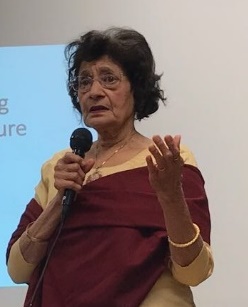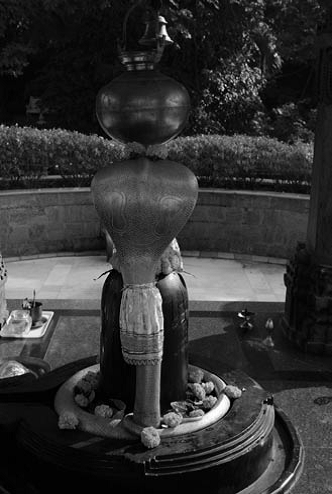Series on Ganesha the Great!

‘Veda’ means to ‘know’ and ‘Understand’. All Vedic Gods are theoretical conceptions perceptible to intellectual pursuit and vision (साक्षात्कार). All Veda-Gītopaniṣadic texts explain these theoretical conceptions, while the Purāṇaetihāsic texts describe the same, via the medium of enchanting entertaining & mind-boggling stories. This mini ‘one_act_play’ in english, is designed to convey this theoretical, as well as, the symbolic stories-based information about Lord Ganesha, as found in the text ‘Ganesha Purāṇa’.

Vyāsa : Oh my god! my dear Grandpā, I am feeling heaviness in my head. My ‘Intellect’ has become ‘still’ like chilled ‘Ice’ and not working properly.
Brahmadeva : My son, please surrender to Lord ‘Ganesha’ who is सिद्धि_बुद्धिपति, the husband or Master of ‘Intellect’ and ‘Success’ and also विघ्नराज the Master commander of all sorts of difficulties.
Vyāsa : Oh Grandpā! who is this Lord Ganesha ? Where is he?
Brahmadeva : My Son, every name of every Vedic God is a ‘meaningful word’ containing the ‘basic qualitative information’, represented by that name of that divine presence. In case of Ganesha, ‘गणानाम् ईश: गणेश:’. The verb ‘gaṇ’ (गण्) means ‘to count’ or ‘to compute’ and ‘Īsha’ means divine owner or ‘Master’. Therefore, ‘Ganesha’ means ‘Divine Master in Computations’. This name of ‘Lord Ganesha’ therefore represents the ‘Divine infinite and instantaneous computational capability’ which is omni-time omni-present everywhere and decides what should happen when, where and how etc., in this entire ‘Universe’. Further, the word ‘gaṇ’ (गण्) is used to denote the ‘accountable or countable followers’. Therefore, every leading ‘Master’ or ‘The Leader’ of every kind of ‘existences’ can be given the ‘Title’ of ‘Ganesha’ e.g. myself, Lord ‘Brahmā’ holds the title of ‘गणेश’ of Satya-loka, Lord Viṣṇu of ‘Vaikuṇṭha-loka’, Lord Śiva or Rudra of ‘Kailāśa-loka’, Lord Indra of ‘Svarga-loka’, etc. as described in a ṛcā (verse) of the Gaṇapati-atharvaśīrṣa. Viz.
त्वम् ब्रह्मास्त्वम् विष्णुस्त्वम् रुद्रस्त्वम् इन्द्रस्त्वम् अग्निस्त्वम् वायुस्त्वम् सूर्यस्त्वम् चन्द्रमास्त्वम् ब्रह्मभूर्भुवः स्वरोम् || (6)
Vyāsa : Oh Grandpā! How can I please him fast enough ?
Brahmadeva : My son, important texts containing this information are Gaṇapati-atharvaśīrṣa, ‘Ganesha Purāṇa and Mudgal Purāṇa. Today, I shall myself brief you about him, as per the information in the text ‘Ganesha Purāṇa’.
Vyāsa : Oh Grandpā! it is indeed very-very kind of you. Please tell me quickly.
Brahmadeva : My son, at the start of the manifestation of this present ‘our Universe’, two demons ‘Madhu’ and ‘Kaiṭabha’ troubled me too much. They even tried to swallow me up. Therefore, on my request, Lord Viṣṇu the divine ‘Protector’ of this Universe, fought with both of them on my behalf, for quite a long time but could not defeat them. Then, he prayed Lord Ganesha and got instructed on the trick to kill them. The ‘clever trick’ was, to praise the demons and boost their foolish ‘Self Ego’ to fly like a kite, high in the sky. Then, offer them a ‘boon’ as if like a ‘donation’ in their appreciation. Due to their highly boosted ‘Self Ego’, they predictably refused to accept the ‘donation’ and in return, they themselves offered to favor Lord Viṣṇu with their ‘donation’ of a boon. He immediately cashed on this opportunity and asked the boon that ‘both should get killed by him’. The fools had got their ‘Self Ego’ so highly raised, by the cunning praises, that they sanctioned this boon and got killed by Lord Viṣṇu.
Vyāsa : Oh Grandpā! it is a great story of how clever ‘ऋद्धि_बुद्धिपति’ Lord Ganesha designed a plan and helped Lord Viṣṇu using cunning ‘Intellectual Power’. The sacred idol in the “Aṣṭa-Vināyaka temple at ‘Siddhatek’, in Maharashtra, India” is believed to have been installed by Lord Viṣṇu, in grateful memory of this episode.
Brahmadeva : Yes, my son. An episode related with one more Aṣṭa-Vināyaka temple is also very interesting. Like the famous child devotees ‘Dhruva’ and ‘Prahlāda’ of Lord Viṣṇu, and ‘Shreekara’ of Lord Śiva, ‘Ballāla’ was a great child devotee of Lord Ganesha. Every day, he used to collect a lot of his teen aged friends and perform the ‘play’ of worship of his Lord. These children used to collect some stones, leaves, flowers etc. and installing one of the stone as Lord Ganesha, perform it’s worship with great devotional emotion. Often, they used to walk a bit distance, away from their mini township and then become quite a bit late to reach back home for their lunch. One of such a day, the parents of a few such children met Ballāla’s father ‘Kalyāṇa’ and complained about this habit of his son. He was a merchant and saw a great loss in his business, as a result of this habit of his son. He therefore, took a stick and went to the place where the children were playing the play of worshiping a stone as Lord Ganesha. He kicked away the stone and scattered all the worship. Then, binding Ballāla with a rope to a nearby tree, he scolded and beat him up squarely. Child Ballāla was too upset by the behavior of his father and especially about the insult he showered on the stone, installed by him as Lord Ganesha. Boiling with anger, he cursed his father ‘to become blind, deaf, dumb & handicapped and suffer in this fashion for several lives’. The child had already earned so much spiritual credits and had reached such a high spiritual level, that his father got a ‘stroke’ like attack by the time he got back home, and did instantly become blind, deaf and dilapidated to walk on his legs or to do any work with his hands. As the child Ballāla was helplessly bound to the tree and suffered injuries inflicted by the stick beating, he kept on crying loudly in pain. All his friends had run away long back, fearing Kalyāṇa’s rage. He however kept on yelling ‘Ganeshā’, ‘Ganeshā’, ‘Gajānanā’ ‘Gajānanā’ etc. and believed that his God will come or send some help. Soon a brahmin priest appeared on the screen and untied the child and applied some medicines on his injuries. Ballāla believed that the Lord Ganesha himself had appeared in that form and built a Ganesha temple at that spot. That temple has become famous as ‘Ballāleshvara Vināyaka Mandira’.
Vyāsa : Oh Grandpā! thanks for telling me this very interesting story related with one of the Aṣṭa-Vināyaka temples, ‘Ballāleshvara’ located at Pāli, Maharashtra.

Dr. Dhananjay B. Ghare, Former Scientist, Indian Institute of Science, Bengaluru




















